Real Time solutions on AT91SAM SoC
Introduction
This page aims at presenting the two most important real-time Linux solutions, their setup and the expected performances on AT91SAM SoCs. The study covers the following two real-time Linux solutions:- The PREEMPT_RT
 patch set
patch set
- The Xenomai
 real-time extension
real-time extension
Global setup
- The board used are the AT91SAM9G20EK, AT91SAM9M10-G45-EK and AT91SAM9263-EK.
- The kernel versions used are the 3.0.10 for the PREEMPT_RT patch and 2.6.38 for Xenomai.
- The root filesystem was generated using Buildroot
 and was mounted over the network through NFS.
and was mounted over the network through NFS.
- The toolchain used was gcc-4.4-2010q1 from CodeSourcery.
Stress during benchmarks
RT benchmarks are only meaningful under heavy stress to guarantee to find worst case latencies. The following programs are used to stress the system:- hackbench to stress the scheduler
- netcat to stress the Ethernet interface and generate a lot of interrupts
- ls and dd for global stress
#!/bin/sh (while true; do cat /usr/share/netcat/netcat.data; sleep 7; done | netcat -vv -l -p 5566 ) & a=$! dd if=/dev/zero of=/dev/null & b=$! while true; do killall hackbench > /dev/null 2>&1; sleep 5; done & d=$! while true; do /bin/hackbench 1 > /dev/null 2>&1; done & e=$! while true; do ls -lR / > /dev/null 2>&1; done & f=$! sleep $1 kill $a $b $c $d $e $f
Latency
When developing real-time applications with a system such as Linux, the typical scenario is the following:- An event from the physical world happens and gets notified to the CPU by means of an interrupt
- The interrupt handler recognizes and handles the event, and then wake-up the user-space task that will react to this event
- Some time later, the user-space task will run and be able to react to the physical world event

PREEMPT_RT
Short presentation
- PREEMPT_RT is a long-term project led by Linux kernel developers Ingo Molnar, Thomas Gleixner and Steven Rostedt.
- The goal is to gradually improve the Linux kernel regarding real-time requirements and to get these improvements merged into the mainline kernel
- PREEMPT_RT development works very closely with the mainline Linux development
- Many of the improvements designed, developed and debugged inside PREEMPT_RT over the years are now part of the mainline Linux kernel
- The project is a long-term branch of the Linux kernel that ultimately should disappear as everything will have been merged
- Development of real-time applications and development of drivers within the PREEMPT_RT patch set applied on the Linux kernel is exactly the same as on a standard Linux kernel. There are no special APIs, no special library. The PREEMPT_RT patch set simply offers more reliable worst-case latencies and more configurable system behaviour (mostly through the configuration of interrupt threads priorities).
Setup
- PREEMPT_RT is delivered as a patch against the mainline kernel
- Best to have a board supported by the mainline kernel, otherwise the PREEMPT_RT patch may not apply and may require some adaptations
- Many official kernel releases are supported, but not all. For example, 2.6.31 and 2.6.33 are supported, but not 2.6.32. (At the end of November 2011 the versions available were 2.6.22, 2.6.24, 2.6.25, 2.6.26, 2.6.29, 2.6.31, 2.6.33, 3.0 and 3.2)
- Quick set up
- Download the latest PREEMPT_RT patch from
http://www.kernel.org/pub/linux/kernel/projects/rt/ - Download and extract the corresponding mainline kernel version
- Apply the patch to the mainline kernel tree
- For example with kernel sources 3.0.12 installed at
/usr/local/src/v3.0.12, the command lines would be:$ cd /usr/local/src/ $ wget http://www.kernel.org/pub/linux/kernel/projects/rt/3.0/patches-3.0.12-rt30.tar.bz2 --2011-12-19 16:43:20-- http://www.kernel.org/pub/linux/kernel/projects/rt/3.0/patches-3.0.12-rt30.tar.bz2 Resolving www.kernel.org... 149.20.4.69 Connecting to www.kernel.org|149.20.4.69|:80... connected. HTTP request sent, awaiting response... 200 OK Length: 252203 (246K) [application/x-bzip2] Saving to: `patches-3.0.12-rt30.tar.bz2' 100%[============================================================================================>] 252,203 113K/s in 2.2s (113 KB/s) - `patches-3.0.12-rt30.tar.bz2' saved [252203/252203] $cd v3.0.12 $bzcat ../patches-3.0.12-rt30.patch.bz2 | patch -p1 patching file lib/scatterlist.c patching file arch/powerpc/platforms/wsp/opb_pic.c patching file drivers/tty/tty_ldisc.c patching file mm/slab.c [...]
- For example with kernel sources 3.0.12 installed at
- Configure the kernel,
$ make ARCH=arm KBUILD_OUTPUT=../build_kernel_atmel at91sam9g20ek_defconfig HOSTCC scripts/basic/fixdep [...] # # configuration written to .config # $ make ARCH=arm KBUILD_OUTPUT=../build_kernel_atmel xconfig
- and be sure to enable
-
CONFIG_PREEMPT_RTCONFIG_HIGH_RES_TIMERS(High Resolution Timer Support)
-
- Download the latest PREEMPT_RT patch from
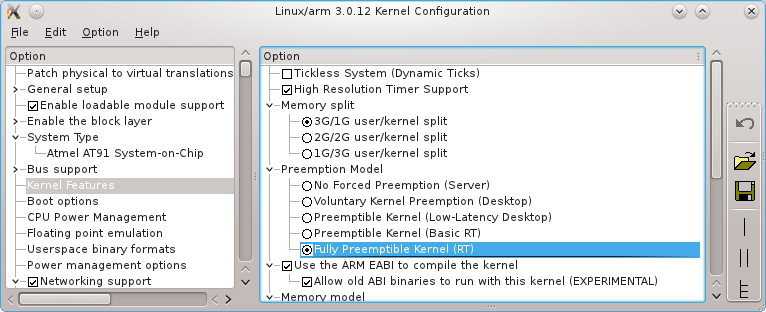
-
-
-
CONFIG_ATMEL_TCLIB(located indrivers/miscmenu)
-
-
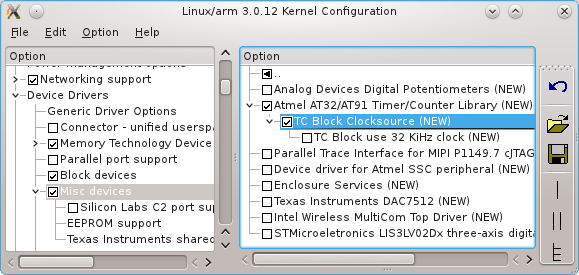
-
- Compile your kernel, and boot
GEN /usr/local/src/build_kernel_atmel/Makefile CHK include/linux/version.h Using /usr/local/src/v3.0.12 as source for kernel CHK include/generated/utsrelease.h make[2]: `include/generated/mach-types.h' is up to date. CALL /usr/local/src/v3.0.12/scripts/checksyscalls.sh CC init/main.o CHK include/generated/compile.h [...] Image Type: ARM Linux Kernel Image (uncompressed) Data Size: 2164096 Bytes = 2113.38 kB = 2.06 MB Load Address: 0x20008000 Entry Point: 0x20008000 Image arch/arm/boot/uImage is ready
- Compile your kernel, and boot
Benchmark
Latency from external signal (through GPIO)
This benchmark reproduces a common use case: a signal comes though a GPIO and after this event a signal is output on another GPIO. All the code runs in userspace using the sysfs gpio interface.It shows the worst case we can expect when the code handling the event is located in an userspace application. Lower latencies can be achieved by handling directly the event inside the kernel, but implementing application-specific code within the kernel is usually much more difficult. What is measured here is the full scheduling latency plus the time spent in the task to set the GPO including the switch in kernel space: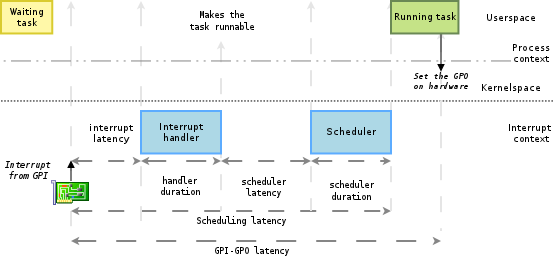
- PB26 is used as input,
- PB10 is used as output,
echo 75 > /sys/class/gpio/export echo out > /sys/class/gpio/gpio75/direction while true; do echo 1 >/sys/class/gpio/gpio75/value; ./microsleep ; echo 0 >/sys/class/gpio/gpio75/value; ./microsleep ; donemicrosleep is just a simple C program calling nanosleep(), for the tests the sleep value was 30 ms. Here is the script used to setup the GPIO (prepare_gpio.sh) on the target board:
#!/bin/sh echo 74 > /sys/class/gpio/export echo out > /sys/class/gpio/gpio74/direction echo 90 > /sys/class/gpio/export echo in > /sys/class/gpio/gpio90/direction echo both > /sys/class/gpio/gpio90/edgeThen the following command line:
./prepare_gpio.sh ; chrt -f 99 ./rttest_gpio & while true; do ./doload.sh 65 ; doneThe source code for rttest_gpio.c is available here rttest_gpio.c This code is compiled with this simple command line:
arm-none-linux-gnueabi-gcc -Wall -o rttest_gpio rttest_gpio.c -lrtOn the following oscilloscope snapshot, we can see what we get after 12 hours on AT91SAM9M10-G45-EK with a 3.0.10-rt27 kernel PREEMPT_RT_FULL selected:
- The input signal is in green and the output signal is in yellow .
- As the oscilloscope triged on the falling edge of the input signal, we barely see this signal at the left of the snapshot.
- The medium green band is due to a small noise on the reference ground.
- Time base is 1ms and 1V by square.
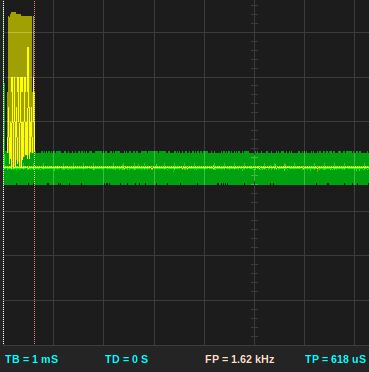
- The input signal is in green and the output signal is in yellow.
- The input signal have a 30ms period. The output signal fill this 30ms and overlap the next input period. So we can only conclude that maximum latency is at least 30ms.
- The medium green band is due to a small noise on the reference ground.
- Time base is 5ms and 1V by square.
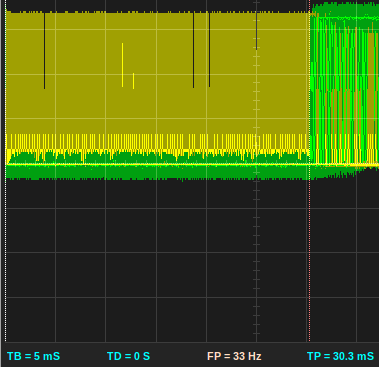
- The input signal is in yellow and the output signal is in green.
- As the oscilloscope triged on the falling edge of the input signal, we barely see this signal at the left of the snapshot.
- Time base is 500us and 1V by square.
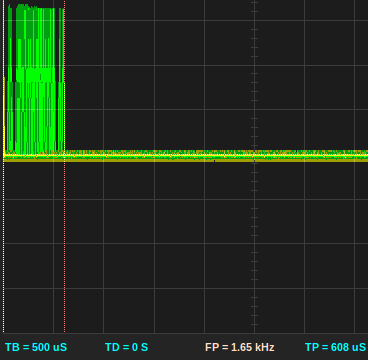
- The input signal is in yellow and the output signal is in green.
- The input signal have a 30ms period. The output signal fill this 30ms and overlap the next input period. So we can only conclude that maximum latency is at least 30ms.
- Time base is 5ms and 1V by square.
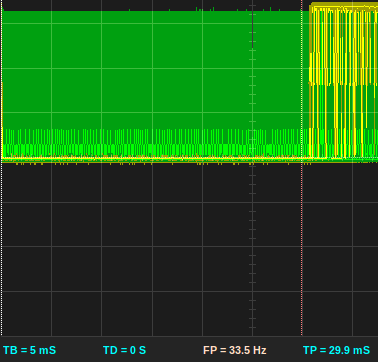
|
||||||||||||||
Timer latency
This benchmark measures the latency timer using cyclictest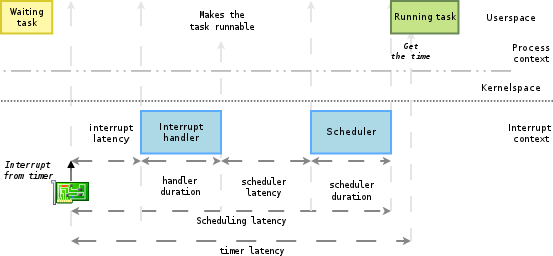
- Using timer_settime (high-resolution POSIX timer), option -s with cyclictest
- Using setitimer (high-resolution interval timer), no option with cyclictest
- Using nanosleep (high-resolution sleep), option -n with cyclictest
- Using clock_nanosleep (high-resolution sleep with clock selection), option -n -s with cyclictest
- AT91SAM9G20 - 3.0.12-rt30+ PREEMPT RT - $cyclictest -m -a -t -n -p99
- Command used - $cyclictest -m -a -t -n -p99
- Benchmark duration: 44 h 30 min
- Number of samples: 160247021
- Min Latencies: 00016 us
- Avg Latencies: 00087 us
- Max Latencies: 00177 us

- AT91SAM9G20 - 3.0.12-rt30+ PREEMPT RT - $cyclictest -m -a -t -p99
- Command used - $cyclictest -m -a -t -p99
- Benchmark duration: 16 h 40 min
- Number of samples: 060037201
- Min Latencies: 00076 us
- Avg Latencies: 00213 us
- Max Latencies: 02136 us
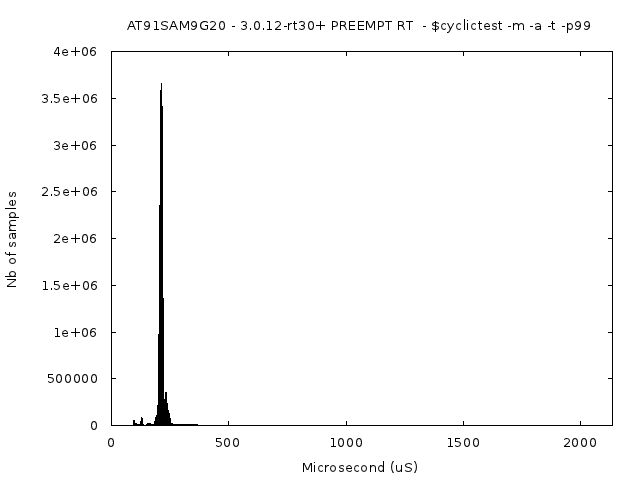
- AT91SAM9G20 - 3.0.12-rt30+ PREEMPT RT - $cyclictest -m -a -t -s -n -p99
- Command used - $cyclictest -m -a -t -s -n -p99
- Benchmark duration: 9 h 47 min
- Number of samples: 035257192
- Min Latencies: 00020 us
- Avg Latencies: 00100 us
- Max Latencies: 50229 us
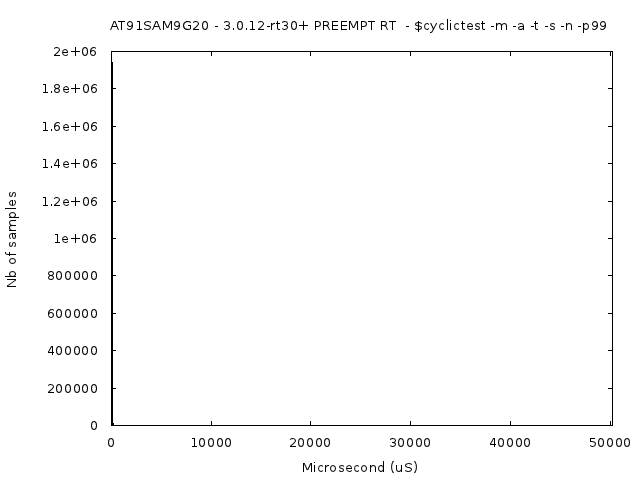
- AT91SAM9G20 - 3.0.12 - $cyclictest -m -a -t -p99
- Command used - $cyclictest -m -a -t -p99
- Benchmark duration: 11 h 09 min
- Number of samples: 031919110
- Min Latencies: 00027 us
- Avg Latencies: 00380 us
- Max Latencies: 39823 us
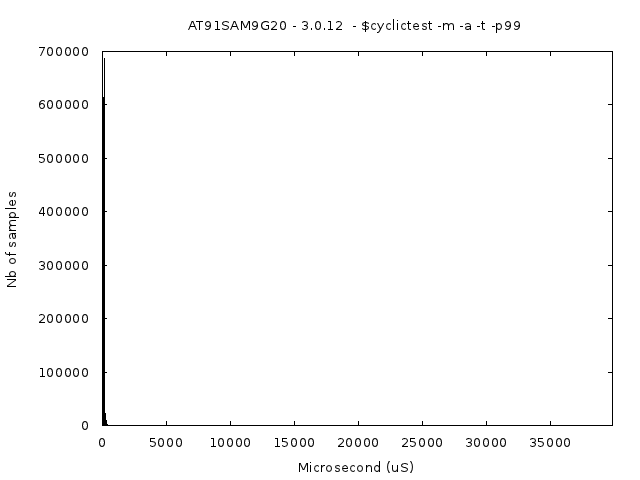
- AT91SAM9G45 - 3.0.12-rt30+ PREEMPT RT - $cyclictest -m -a -t -p99
- Command used - $cyclictest -m -a -t -p99
- Benchmark duration: 54 h 29 min
- Number of samples: 196190335
- Min Latencies: 00070 us
- Avg Latencies: 00219 us
- Max Latencies: 01106 us
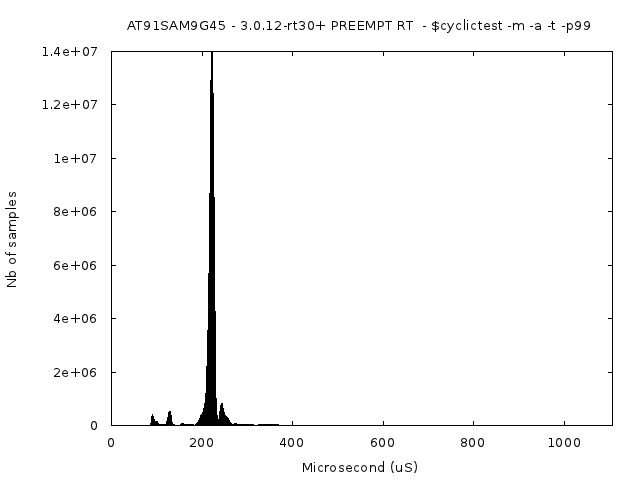
- AT91SAM9G45 - 3.0.12-rt30+ PREEMPT RT - $cyclictest -m -a -t -s -n -p99
- Command used - $cyclictest -m -a -t -s -n -p99
- Benchmark duration: 33 h 1 min
- Number of samples: 118900140
- Min Latencies: 00021 us
- Avg Latencies: 00106 us
- Max Latencies: 00264 us
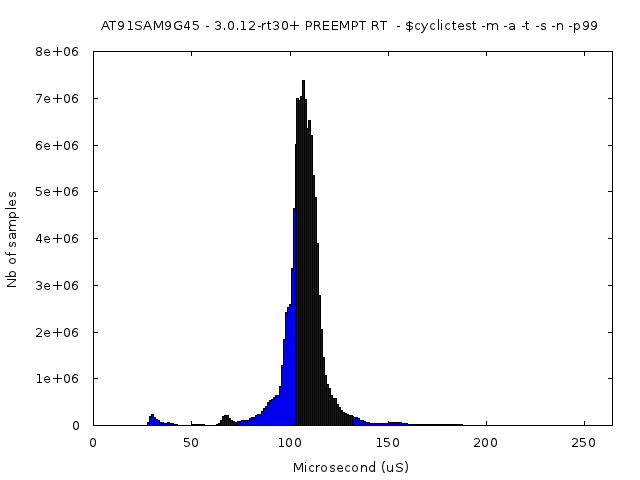
- AT91SAM9G45 - 3.0.12-rt30+ PREEMPT RT - $cyclictest -m -a -t -s -p99
- Command used - $cyclictest -m -a -t -s -p99
- Benchmark duration: 29 h 22 min
- Number of samples: 105720602
- Min Latencies: 00100 us
- Avg Latencies: 02441 us
- Max Latencies: 03861 us
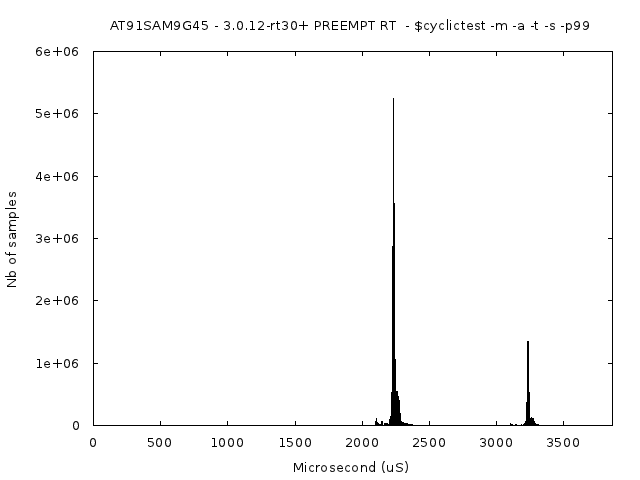
- AT91SAM9G45 - 3.0.12 - $cyclictest -m -a -t -p99
- Command used - $cyclictest -m -a -t -p99
- Benchmark duration: 11 h 02 min
- Number of samples: 030618980
- Min Latencies: 00032 us
- Avg Latencies: 00503 us
- Max Latencies: 94991 us
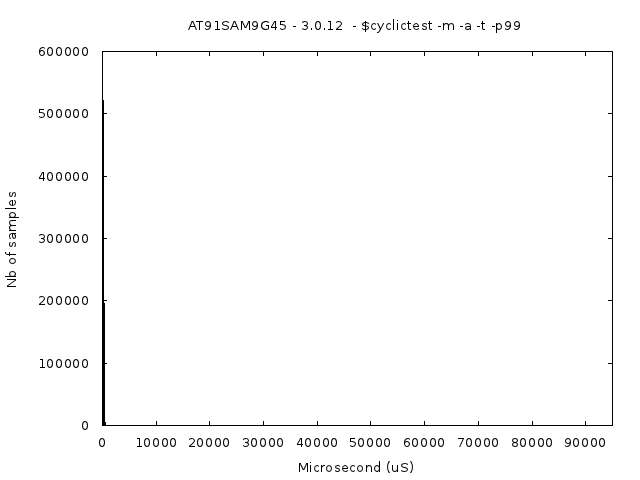
Xenomai
Short presentation
- Xenomai Started in 2001 as a project aiming at emulating traditional RTOS.
- The initial goal is to make it easier to port programs to GNU/Linux by providing skins mimicking the APIs of traditional RTOS such as VxWorks, pSOS+, and VRTXsa as well as the POSIX API, and a “native” API.
- It was initially related to the RTAI project (as the RTAI / fusion branch), but it is now independent.
- Real-time applications in Xenomai cannot use the Linux device drivers, so special device drivers must be written for the devices that are involved with the real-time tasks. Those drivers cannot benefit from the existing hardware support in Linux, and must be rewritten independently.
- Real-time applications in Xenomai are generally written against the native skin (a Xenomai API) or the POSIX skin (which reproduces the traditional API in Linux but binds it to Xenomai calls)
Setup
- Download Xenomai sources at http://download.gna.org/xenomai/stable/

- Download one of the Linux versions supported by this release (see
ksrc/arch/arm/patches/) - Since version 2.0, split kernel/user building model, kernel uses a script called script/prepare-kernel.sh which integrates Xenomai kernel-space support in the Linux sources.
- For example with Xenomai 2.6.0 and a kernel sources 2.6.38.8 installed at
/usr/local/src/v2.6.38.8, the command lines would be:cd xenomai-2.6.0 ./scripts/prepare-kernel.sh --arch=arm --linux=/usr/local/src/v2.6.38.8
- For example with Xenomai 2.6.0 and a kernel sources 2.6.38.8 installed at
- Kernel
- Configure kernel, for example fot AT91SAM9G20-EK:
$ make at91sam9g20ek_defconfig HOSTCC scripts/basic/fixdep HOSTCC scripts/basic/docproc GEN /mnt/open/kernel/build_kernel_atmel-xeno/Makefile [...] # # configuration written to .config #
- and be sure to enable
- Xenomai:
CONFIG_XENOMAI
- Xenomai:
- Configure kernel, for example fot AT91SAM9G20-EK:
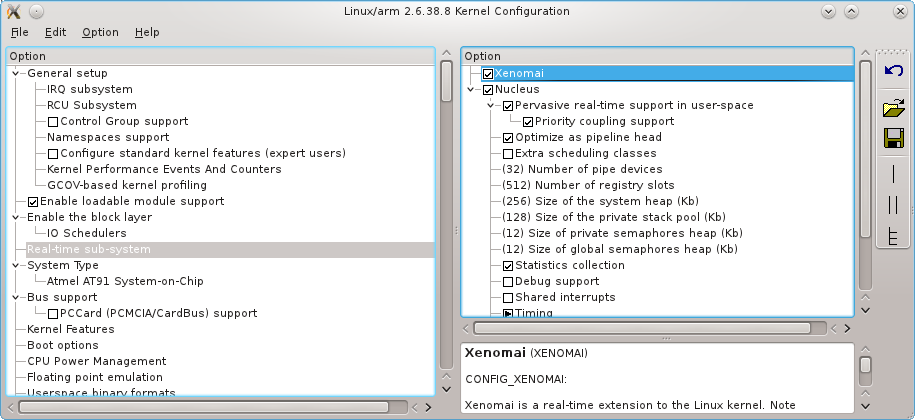
-
-
- Fast Swicth Context Extension (FCSE):
CONFIG_ARM_FCSE_GUARANTEED
- Fast Swicth Context Extension (FCSE):
-
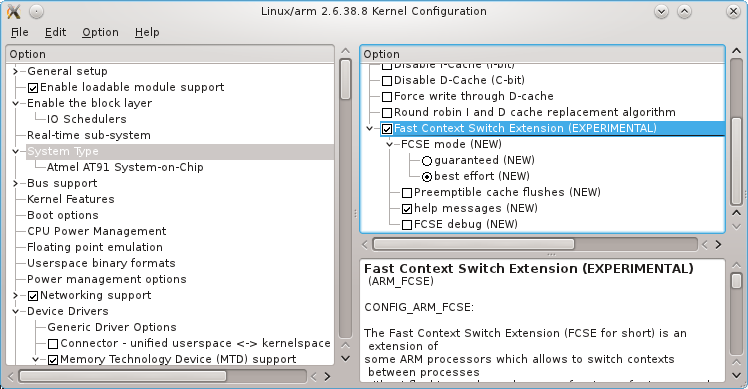
-
-
- High Resolution Timer Support
CONFIG_HIGH_RES_TIMERS(see PREEMPT_RT part) -
CONFIG_ATMEL_TCLIB(see PREEMPT_RT part)
- High Resolution Timer Support
-
- Userspace
- User-space libraries are compiled using the traditional autotools. In the following examples, CFLAGS and LDFLAGS are set with march=armv5, because the toolchain used is the one provided by Linaro which will compile by default for armv7 whereas the
AT91SAMfamily are amrv5/home/gclement/xenomai-2.6.0$ ./configure --build=i686-pc-linux-gnu --host=arm-linux-gnueabi CFLAGS="-march=armv5" LDFLAGS="-march=armv5" checking build system type... i686-pc-linux-gnu checking host system type... arm-unknown-linux-gnueabi checking for a BSD-compatible install... /usr/bin/install -c [...] config.status: linking ./include/asm-generic to src/include/asm-generic/xenomai config.status: executing depfiles commands config.status: executing libtool commands /home/gclement/xenomai-2.6.0$ make Making all in src make[1]: Entering directory `/home/gclement/xenomai-2.6.0/src' Making all in include make[2]: Entering directory `/home/gclement/xenomai-2.6.0/src/include' make all-am make[3]: Entering directory `/home/gclement/xenomai-2.6.0/src/include' make[3]: Leaving directory `/home/gclement/xenomai-2.6.0/src/include' make[2]: Leaving directory `/home/gclement/xenomai-2.6.0/src/include' Making all in skins make[2]: Entering directory `/home/gclement/xenomai-2.6.0/src/skins' Making all in common make[3]: Entering directory `/home/gclement/xenomai-2.6.0/src/skins/common' /bin/sh ../../../libtool --tag=CC --mode=compile arm-linux-gnueabi-gcc -DHAVE_CONFIG_H -I. -I../../../src/include -O2 -D_GNU_SOURCE -D_REENTRANT -Wall -Werror-implicit-function-declaration -pipe -D__XENO__ -D__IN_XENO__ -Wstrict-prototypes -I../../../include -march=armv5 -MT libxenomai_la-assert_context.lo -MD -MP -MF .deps/libxenomai_la-assert_context.Tpo -c -o libxenomai_la-assert_context.lo `test -f 'assert_context.c' || echo './'`assert_context.c [...] make[1]: Leaving directory `/home/gclement/xenomai-2.6.0/scripts' make[1]: Entering directory `/home/gclement/xenomai-2.6.0' make[1]: Nothing to be done for `all-am'. make[1]: Leaving directory `/home/gclement/xenomai-2.6.0' /home/gclement/xenomai-2.6.0$ make DESTDIR=/home/gclement/rootfs/ install Making install in src make[1]: Entering directory `/home/gclement/xenomai-2.6.0/src' Making install in include [...] [sudo] password for gclement: sudo is working. make[2]: Nothing to be done for `install-data-am'. make[2]: Leaving directory `/home/gclement/xenomai-2.6.0' make[1]: Leaving directory `/home/gclement/xenomai-2.6.0' /home/gclement/xenomai-2.6.0$
- The xeno-config script, installed when installing Xenomai user-space support helps you to compile your own programs. This scripts need to know where the libraries and the headers have been installed. DESTDIR must be set to point to the staging root file system:
- User-space libraries are compiled using the traditional autotools. In the following examples, CFLAGS and LDFLAGS are set with march=armv5, because the toolchain used is the one provided by Linaro which will compile by default for armv7 whereas the
/home/gclement/$ export DESTDIR=/home/gclement/rootfs/ /home/gclement/$ arm-linux-gnueabi-gcc `xeno-config --skin=posix --cflags` -o rttest_xeno rttest.c `xeno-config --skin=posix --ldflags` /home/gclement/$ file rttest_xeno rttest_xeno: ELF 32-bit LSB executable, ARM, version 1 (SYSV), dynamically linked (uses shared libs), for GNU/Linux 2.6.31, not stripped
-
- See Xenomai's examples directory for more example.
- Installation details may be found in the README.INSTALL guide.
- For an introduction on programming with the native Xenomai API, see: http://www.xenomai.org/documentation/branches/v2.4.x/pdf/Native-API-Tour-rev-C.pdf

- For an introduction on programming with the POSIX API, see: http://www.xenomai.org/index.php/Porting_POSIX_applications_to_Xenomai

- Another option which is more straightforward is to use Buildroot
 which now integrates support for Xenomai
which now integrates support for Xenomai
Benchmarks
Benchmarks are done using the latency program provided with Xenomai. It comes in 3 flavors:- User task: periodic user-mode task

- Kernel Task: in-kernel periodic task
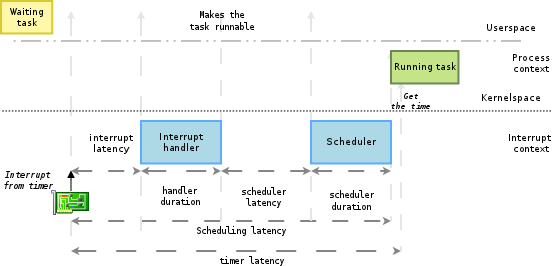
- Timer IRQ: in-kernel timer handle
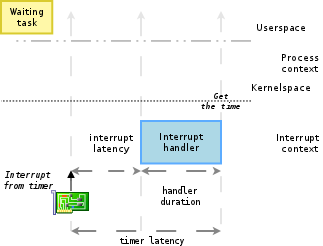
-
CONFIG_HIGH_RES_TIMERS -
CONFIG_ATMEL_TCLIB -
CONFIG_ATMEL_TCB_CLKSRC -
CONFIG_XENOMAI -
CONFIG_XENO_DRIVERS_TIMERBENCH -
CONFIG_ARM_FCSE_GUARANTEED -
CONFIG_XENO_HW_UNLOCKED_SWITCH
- For User task:
while true; do ./doload.sh 65 & ; done & latency
- For Kernel task:
while true; do ./doload.sh 65 & ; done & latency -t1
- For Timer IRQ:
while true; do ./doload.sh 65 & ; done & latency -t2
- AT91SAM9G20-EK - 2.6.38.8-ipipe+ - $latency -h -H10000 -P99 -T36000 -q
- Command used - $latency -h -H10000 -P99 -T36000 -q
- Benchmark duration: 10 h 00 min
- Number of samples: 35999927
- Min Latencies: 8.720 us
- Avg Latencies: 32.945 us
- Max Latencies: 106.589 us
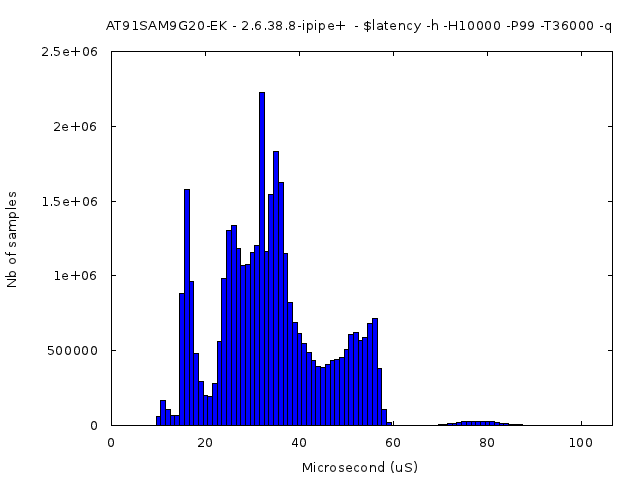
- AT91SAM9G20-EK - 2.6.38.8-ipipe+ - $latency -h -H10000 -t1 -P99 -T36000 -q
- Command used - $latency -h -H10000 -t1 -P99 -T36000 -q
- Benchmark duration: 10 h 00 min
- Number of samples: 35999817
- Min Latencies: 3.876 us
- Avg Latencies: 19.065 us
- Max Latencies: 42.542 us
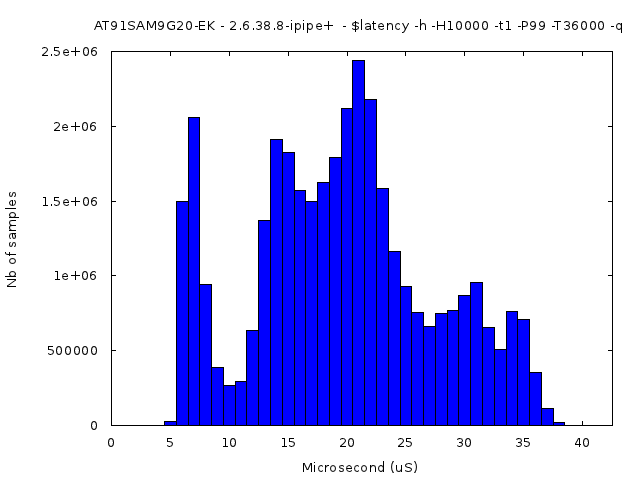
- AT91SAM9G20-EK - 2.6.38.8-ipipe+ - $latency -h -H10000 -t2 -P99 -T36000 -q
- Command used - $latency -h -H10000 -t2 -P99 -T36000 -q
- Benchmark duration: 10 h 00 min
- Number of samples: 35999845
- Min Latencies: 0.000 us
- Avg Latencies: 6.607 us
- Max Latencies: 21.240 us
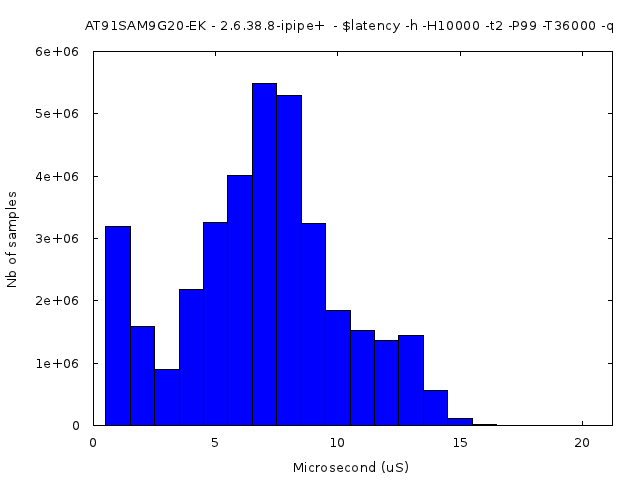
- AT91SAM9M10G45-EK - 2.6.38.8-ipipe+ - $latency -h -H10000 -P99 -T36000 -q
- Command used - $latency -h -H10000 -P99 -T36000 -q
- Benchmark duration: 10 h 00 min
- Number of samples: 36022992
- Min Latencies: 6.720 us
- Avg Latencies: 34.560 us
- Max Latencies: 118.080 us
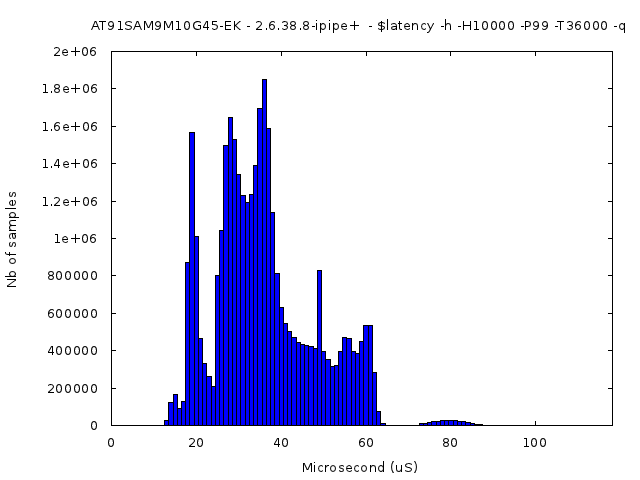
- AT91SAM9M10G45-EK - 2.6.38.8-ipipe+ - $latency -h -H10000 -t1 -P99 -T36000 -q
- Command used - $latency -h -H10000 -t1 -P99 -T36000 -q
- Benchmark duration: 10 h 00 min
- Number of samples: 35999920
- Min Latencies: 1.087 us
- Avg Latencies: 19.414 us
- Max Latencies: 47.028 us
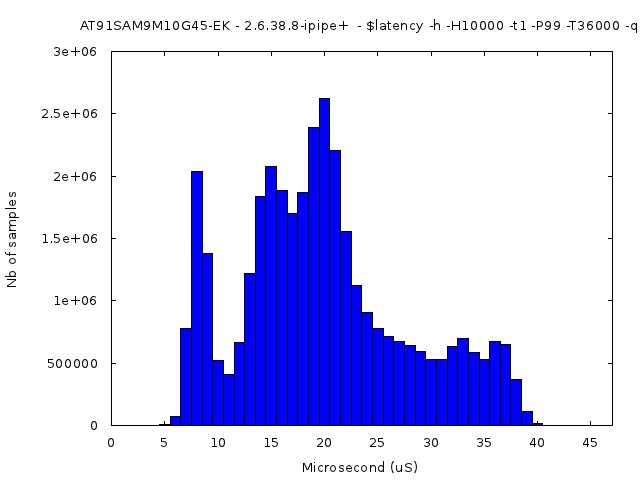
- AT91SAM9M10G45-EK - 2.6.38.8-ipipe+ - $latency -h -H10000 -t2 -P99 -T36000 -q
- Command used - $latency -h -H10000 -t2 -P99 -T36000 -q
- Benchmark duration: 10 h 00 min
- Number of samples: 35999830
- Min Latencies: -3.835 us
- Avg Latencies: 6.343 us
- Max Latencies: 21.106 us
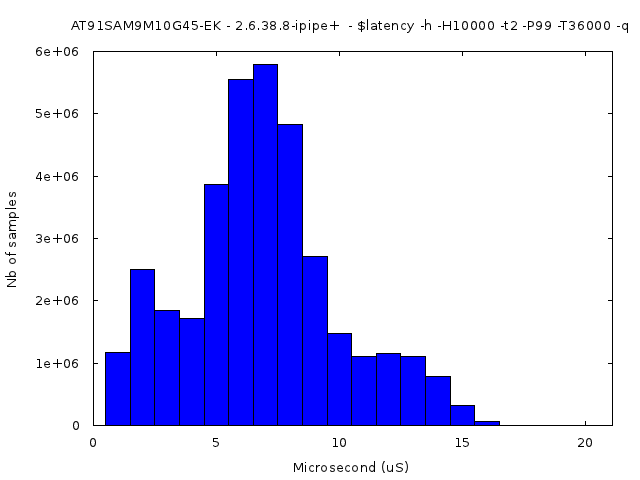 For AT91SAM9263-EK, each test ran during at least 3 hours.
For AT91SAM9263-EK, each test ran during at least 3 hours.
|
||||||||||||||
References
- Websites
- The Wiki Web for the CONFIG_PREEMPT_RT community, and real-time Linux in general. Real-Time Linux Wiki

- Information about Real-time usage of Linux hosted by CE Linux Forum Real Time - elinux.org
 . There are less information than the previous website but it have some references on more recent paper or presentations.
. There are less information than the previous website but it have some references on more recent paper or presentations.
- OSADL Project: Realtime Linux
 . The most intersting point is their realtime latency testing farm.
. The most intersting point is their realtime latency testing farm.
- Xenomai web site
 and Adeos
and Adeos
- The Wiki Web for the CONFIG_PREEMPT_RT community, and real-time Linux in general. Real-Time Linux Wiki
- Books
- Building Embedded Linux systems 2nd Edition
- Papers
- Comparison between Xenomai, PREEMPT_RT and vanilla Linux on an (Beagle Board ARMv7 architecture). How fast is fast enough? Choosing between Xenomai and Linux for real-time applications / Jeremy Brown and Bradly Martin, Rep Invariant Systems, inc., USA

- Comparison between Xenomai, PREEMPT_RT and vanilla Linux on an (Beagle Board ARMv7 architecture). How fast is fast enough? Choosing between Xenomai and Linux for real-time applications / Jeremy Brown and Bradly Martin, Rep Invariant Systems, inc., USA
| WebFaqBaseForm | |
|---|---|
| Boards | AT91sam9x5-ek, other AT91SAM9 boards |
| Components | Kernel |
| Summary | Enable Real Time support for AT91SAM9 Soc |
r28 - 09 Sep 2016 - 08:25:11 - NicolasFerre
Linux4SAM
Open source solutions ApplicationsBoards
- SAM9X75 Curiosity
- SAMA5D29 Curiosity
- SAM9X60 Curiosity
- SAMA7G5-EK
- SAMA5D2-ICP
- SAMA5D27 WLSOM1 EK
- SAM9X60-EK
- SAMA5D27 SOM1 EK
- SAMA5D2 PTC EK
- SAMA5D2 Xplained
- SAMA5D3 Xplained
- SAMA5D4 Xplained
- Older boards
FAQ
Useful links
- Microchip Microprocessors forums
- AT91 Community (archive)
- Microchip
- Linux4Microchip on GitHub
- Linux4SAM on GitHub
NAVIGATION
Copyright © by the contributing authors. All material on this collaboration platform is the property of the contributing authors.
Linux® is the registered trademark of Linus Torvalds in the U.S. and other countries.
Microchip® and others, are registered trademarks or trademarks of Microchip Technology Inc. and its subsidiaries. ![]()
Arm® and others are registered trademarks or trademarks of Arm Limited (or its affiliates). Other terms and product names may be trademarks of others.
Ideas, requests, contributions ? Connect to LinksToCommunities page.


